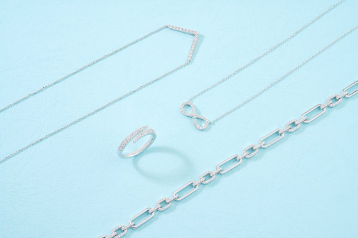
The only similar thing about platinum and white gold is their appearance, to a non-discerning eye, that is. The precious metal platinum and the alloy white gold couldn’t be more different, whether it’s their appearance in the long run, how they are harnessed and hardened for jewelry, and the price you pay to get your hands on them or the price you get when you sell them, as the case may be in today’s blog.
Our doors are always open if you want to resell white gold, platinum, or any of the items mentioned on our website. The point of today’s update is to tell you which of these two will be valued more after you search for online gold buyers.
What better than having a gold buyer’s perspective on the resale price of platinum and white gold? Let’s start from the top.
Platinum vs. White Gold: What Do the Numbers Say?
Deciding whether to sell your platinum or white gold jewelry can be trickier than it sounds. For one, platinum can supersede gold, white, or otherwise, regarding the spot price. For another, its resale value is more volatile than gold.
You see, for all the value platinum earns due to its rarity, it doesn’t have the market reputation of gold. Therefore, reselling the latter instead of the former is easier and more lucrative for a seller.
The per-ounce price of platinum was $1,029.00 as of June 5, 2023.
At the same time, an ounce of gold was trading at $1,961.83.
Platinum isn’t doing so well, but you may find a higher percentage (more than 95%) of this metal in your jewelry. We can’t say the same for white gold jewelry, as it’s too soft in its pure form (24k) to be suitable for jewelry.
Thus, your gold jewelry may have an 18k or 14k stamp, denoting that it contains at least 58–75 percent of the precious metal; the rest might be a mixture of white metals like nickel, silver, and palladium.
All said, your platinum jewelry is likely to contain more platinum than your white gold jewelry is to contain gold, other white metals notwithstanding. While the selling price of gold is twice that of platinum, it ultimately comes down to the precious metal content in your jewelry.
Platinum vs. White Gold: Which is Harder to Maintain?
There’s more to platinum and white gold than resale price. When selling gold jewelry online, you might come across offers based on the condition of your jewelry; it’s one of the appraisal factors at Gold to Cash.
Platinum and white gold are common metals for wedding bands and engagement rings. You don’t reserve such items for special occasions. They are designed to be worn every day and withstand the wear and tear.
Although platinum is heavier than pure gold, it is bendable and has a surface highly susceptible to scratching. It requires more day-to-day care and polishing to maintain a pristine appearance. A scratch is all it takes to affect the resale value of your platinum jewelry.
Conversely, white gold jewelry is solid and durable, thanks to the cocktail of metals and scratch-resistant rhodium plating. It maintains its appearance in the long run, making you more likely to get a closer-to-market rate offer. You can also wait for the price to rise before selling gold jewelry online.
Platinum vs. White Gold: Do They Tarnish?
While most metals are vulnerable to discoloration caused by oxidation, platinum, and white gold jewelry are valued for their resistance to the chemical reaction. Platinum, gold, silver, and palladium are noble metals, meaning you can leave them at the mercy of natural elements (air, humidity, and water), and they will not react to them and maintain the underlying metal’s shiny appearance.
Since platinum jewelry contains a higher platinum percentage, it seldom tarnishes. If your jewelry contains 95% platinum, the remaining 5% is likely to be other noble metals, lending more resistance to the jewelry.
On the other hand, white gold jewelry’s oxidation resistance is conditional. It is quite resistant to the outside elements and chemicals like sulfur and chlorine if it contains at least 58% gold and has rhodium plating. Any lower, and your jewelry’s resistance to the phenomenon takes a hit, to say nothing of the resale value of this jewelry.
Therefore, it is better to resell it sooner, preferably before your jewelry starts showing signs of tarnishing.
Platinum vs. White Gold: The Wrap Up
Platinum jewelry might cost a few hundred dollars more upfront, but it doesn’t require costly plating every once in a while, like white gold jewelry. The latter’s buying price is conditional on the pure gold content, but restoring its appearance can be more costly.
Fortunately, gold jewelry is more stable than its platinum counterpart. Therefore, you are more likely to get back what you initially paid. Reselling white gold jewelry is more profitable than reselling your platinum baubles due to the following reasons:
· Lower demand for platinum.
· Easier to melt down gold.
· More challenging to reuse platinum from jewelry.
Deciding which precious item to part with is entirely your prerogative.
Sell Platinum and Gold Jewelry Online for Cash
Finding takers for your platinum jewelry is difficult but not impossible. Conversely, there is no shortage of selling opportunities for your white gold jewelry. However, gold buyers are a dime a dozen.
Look around; online gold buyers would only be open to offering you up to 95% of the market price for the underlying metal in your jewelry. This exception to the rule is the main reason behind our exceptional appraisals that have earned a 4.8-star rating on Trustpilot.
Get in touch to share your feedback and queries.